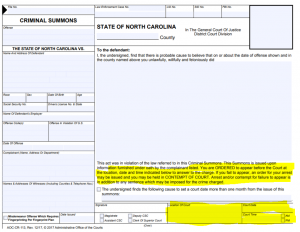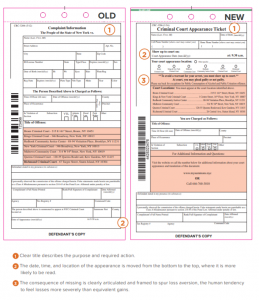In a series of posts I’ve been discussing bail reform in North Carolina and various options to reduce pretrial detentions that do more harm than good. Some of the solutions are tough and complicated. Here I offer one potential solution that’s neither hard nor complex: Redesign the Criminal Summons form.
In North Carolina, one of the ways that defendants are charged with criminal offenses is with the Criminal Summons. See generally G.S. 15A-303 (criminal summons). The Criminal Summons is issued upon a finding of probable cause. Id. at -303(c). The Summons doesn’t authorize the defendant to be taken into custody, rather it orders the person to appear in court to answer the charges. Id. at -303(a) & (d). If the defendant doesn’t show up as required, we call this a failure to appear or FTA for short. The court can respond to a FTA by issuing an order for arrest (OFA). Id. at -303(e)(2). As its name implies, the OFA results in an arrest. G.S. 15A-305(a). As with all arrests, the defendant must be taken before a judicial official without unnecessary delay for an initial appearance, where a judicial official determines conditions of pretrial release. See G.S. 15A-511. If the judge who issued the OFA doesn’t recommend conditions of release, the FTA requires the judicial official conducting the initial appearance to set a minimum $1000 secured bond. G.S. 15A-534(d1). As I discussed in my previous post on bail reform, that secured bond can lead to wealth-based detentions. When those wealth-based detentions are for low-level offenses (typically what is charged in a Criminal Summons), a host of negative consequences can result, not just for defendants in terms of negative case, social, and financial outcomes, but also to taxpayers in terms of unnecessary jail costs and communities in terms of more crime down the road.
As should be clear from this discussion, significant consequences attach to FTAs, even for relatively minor crimes. In light of that, it might be surprising to see just how little emphasis is given to those consequences on the Criminal Summons form (AOC-CR-113). Here is what the form looks like, with the key language highlighted in yellow:
The information is all there—it orders the person to appear in court and tells them that if they FTA an OFA may be issued. But the warning isn’t very prominent. Does that matter?
One recent study (here) found that a redesign of a summons form to emphasize court date and consequences of failing to appear reduced FTAs by 13%. That’s a lot of benefit from a form tweak. In the study, researchers redesigned the New York City summons form to make the most relevant information stand out. In the revised form, information about court date and location was moved to the top of the form, the negative consequences of failing to appear are boldly displayed, and clear language encourages recipients to act accordingly. Here’s a side-by-side comparison of the old and new forms, highlighting the changes:
The redesigned NYC summons form was introduced in March 2016. To isolate the impact of the new summons form from other factors that might impact FTAs, researchers compared outcomes between defendants who were issued the old form versus the new one using a quasi-experimental approach called regression discontinuity design. Again, they found that those who received the new form had a FTA rate that was 13% lower than those who received the old form. Considering cost-benefit analysis, researchers noted that using the new form has exactly the same cost as using the old one. The only new cost was that associated with the one-time form change. By contrast, the researchers noted that the costs of failing to appear in court are much higher, with impacts for courts and law enforcement, and for defendants who end up incarcerated as a result of an OFA issued after a FTA.
If these study results hold true in North Carolina, there could be tremendous benefits to the court system, law enforcement, defendants, taxpayers and communities from a simple form change. I have already sent this post to members of North Carolina’s Criminal Forms Committee. Stay tuned for whether this gets any traction. If it does, might the Citation form be next?


Should we assume the defendant’s address and other identifying information are on the back of the new NYC form or was it omitted altogether?
In the case of the NY Summons, the original one did not even have the consequences on it. The NC one does and it clearly says, some in all caps, the consequences for failing to appear. I feel like this is part of a push to further lower any standards of personal responsibility that one should have.
I’ve heard that point before. Here’s something to consider: When a Def FTAs, the officer has wasted time coming to court, ready for the case. Ditto for the judge, prosecutor, defense lawyer, and victim. And when the FTA is issued, law enforcement has to deploy officers to make the arrest, which takes more officer time. Then there’s the resources that have to be used for a new initial appearance before the magistrate after the arrest and booking at the jail. And of course there are the jail costs for a Def now subject to mandatory bond doubling who can’t make bail on the original low-level charges. A form redesign has potential to save some of that wasted time, for virtually no cost. Just food for thought as we think about the big picture. Thanks for your feedback.
Sometimes less information is more effective. When I send notices to clients about court dates, I try to stick with something like:
Dear Joe:
You need to be in courtroom 5A at 10 a.m. on April 15, 2019.
It is hard for that message to get lost in the clutter.
I did the same thing when I was in private practice. But I added a line in bold that notified them they would be arrested if they did not come to court.
Simple is better.
And I agree with Stan. This shouldn’t be difficult. Come to court when you are supposed to. I think it really comes down to an issue of respect for the court. If you believe that the court will force compliance if you do not do as you are told, then you will come. Unfortunately the reality is that too often OFAs are not systematically served so it becomes a lottery. And defendants think “if I don’t go, I might be picked up but maybe not too” so they choose to do other things.
And this is a societal problem. I don’t know the answer, and support a change like this that makes it clearer.
I agree with Stan Smith in that ALL concerned need to read the entire form and adhere to the instructions. Nowadays one can document, or write the appointment on their calendars, in addition to even using the calendar and alarm app on your cell phone as a reminder. The summons can be neon yellow and red and folks will still inevitably forget and/or disregard the instructions on the form, in my opinion. Fact is that some people are simply irresponsible.
As I discuss in my blog post, the evidence shows that a simple change to the form positively impacted appearance rates. Did it eliminate all FTAs? Nope. Did it help? Yup. In NC if we pair it with a meaningful court reminder system, we might be on to something!
This Bond pilot program in Haywood and Jackson County has caused a ten fold increase in FTAs. How is a simple change in paperwork going to change that? Leave the bonds alone and hold people accountable!
I am working on the Haywood and Jackson project. Empirical evaluation is ongoing but research to date directly contradicts the statement in your comment about increased FTAs. I encourage you to reach out and to participate in information sharing meetings where research results from that project will be shared.